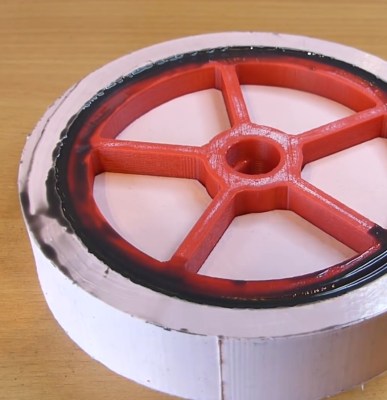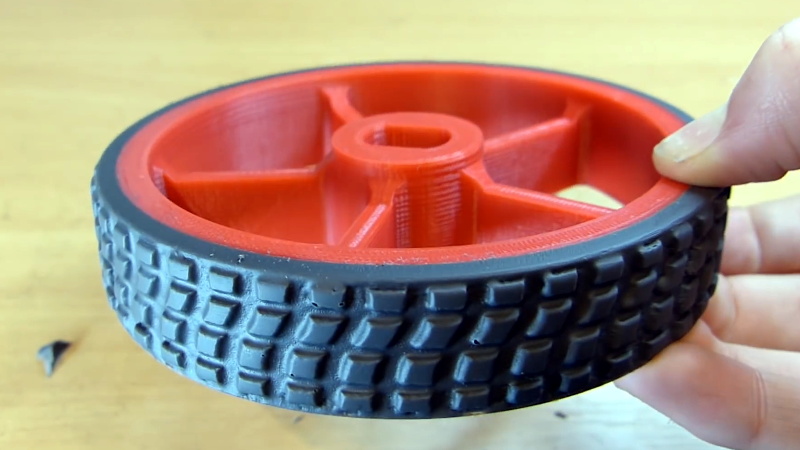You’d be hard-pressed to find more ardent supporters of 3D printing then we here at Hackaday; the sound of NEMA 17 steppers pushing an i3 through its motions sounds like a choir of angels to our ears. But we have to admit that the hard plastic components produced by desktop 3D printers aren’t ideal for a number of applications. For example, the slick plastic is useless for all but the most rudimentary of wheels. Sure there are flexible filaments that can give a printed wheel a bit of grip, but they came with their own set of problems (not to mention, cost).
 In the video after the break, [Design/Forge] demonstrates a clever method for fitting polyurethane rubber “tires” onto 3D printed hubs which is sure to be of interest to anyone who’s in the market for high quality bespoke wheels for their project. The final result looks extremely professional, and while there’s a considerable amount of preparation that goes into it, once you’re set up you should be able to pump these out quickly and cheaply.
In the video after the break, [Design/Forge] demonstrates a clever method for fitting polyurethane rubber “tires” onto 3D printed hubs which is sure to be of interest to anyone who’s in the market for high quality bespoke wheels for their project. The final result looks extremely professional, and while there’s a considerable amount of preparation that goes into it, once you’re set up you should be able to pump these out quickly and cheaply.
The process begins with a 3D printed mold pattern, which includes the final tire tread texture. This means you can create tire treads of any design you wish, which should have some creative as well as practical applications. The printed part is then submerged in silicone rubber and allowed to cure for 8 hours. Once solidified, the silicone rubber becomes the mold used for the next steps, and the original printed part is no longer needed.
The second half of the process is 3D printing the wheels to which the tires will be attached. These will be much smaller than the original 3D printed component, and fit inside of the silicone mold. The outside diameter of the printed wheel is slightly smaller than the inside diameter of the mold, which gives [Design/Forge] the space to pour in the pigmented polyurethane rubber. The attentive viewer will note that the 3D printed wheel has a slight ribbed texture designed into it, so that there will be more surface area for the polyurethane to adhere to. Once removed from the mold and cleaned up a bit, the final product really does look fantastic; and reminds us of a giant scale LEGO wheel.
Whether you’re casting metal parts or just want a pair of truly custom earbuds, creating silicone molds from 3D printed parts is an extremely useful skill to familiarize yourself with. Though even if you don’t have a 3D printer, there’s something to be said for knowing how to mold and cast real-world objects as well.
[Thanks to Itay for the tip.]
















Part of me has wondered about the cost of the polyurethane rubber. For some reason castors (small wheels) around here are seemingly expensive for what they are. I’ve been slowly making mobile working carts for the garage so that if I need a tool, I can wheel it to where I need it. With the little wheels being so expensive, I’ve been wondering about cheaper alternatives.
Try this, it’s super cheap. Skip to about 6:40 for the wheel section.
https://youtu.be/BnZAD1odYoA
“This means you can create tire treads of any design you wish, which should have some creative as well as practical applications. ”
I remember seeing on a number of old cars in the Forney Transportation Museum, tires/tyres with “No Skid” embossed in the tire/tyre treads.
Cost is not too bad; about $45/qt. locally for me:
https://www.tapplastics.com/product/mold_making_materials/mold_making_supplies/tap_urethane_rtv_mold_making_system/63
Funny, I have my printer going right next to me printing something very similar for my robot. Though I am just printing TPU tread directly onto the wheels. My experiments with this in the past have been pretty successful.
I thought that’s what article was going to be about when I saw the headline in my feed. Printed TPU is incredibly durable and “grippy”. I love using it for flexible parts. You just gotta print it slow (25 mm/s is my go-to), keep the temp down to right before it wants to boil/get bubbly, and extrude fatter if you can (0.6 mm nozzle and 0.4 mm layer height).
I agree TPU works great, I’ve printed little 10mm tires that push straight onto a tiny motor upto 60mm hollow RC car tires and they’re awesome. Rugged and grippy, so whilst messing about with moulds is fine for special types of tires I really wouldn’t waste my time with it. My 1kg roll of TPU was only £12 too so only slightly more expensive than a standard roll of PLA!!!
There are some great silicone moulding compounds now which don’t need the extra complication of degassing. One example is Smooth-On Mold Max 29NV, but there are others. Degassing was one step keeping me out of the moulding game, as it takes a bunch of bulky equipment I didn’t want to accumulate, set up or store.
You can make process even quicker by using hot melt vinyl like this
https://tiranti.co.uk/product-category/mouldmaking/hot-melt-vinyl-rubber-ancillaries/vinamold/
I thought you were going to say hot glue.
Hmm
Have you guys made any longboard wheels with this rubber material yet?
I would love to try 4 wheels made of this .. Would it hold my 178lbs weight?